2. 中国电子科技集团公司第38研究所, 安徽 合肥 230088
2. China Electronics Technology Group Corporation No.38 Research Institute, Hefei 230088, China
底部排气弹是指在弹丸底部附加一个排气装置, 在弹丸高速飞行中向弹底低压区排入质量和能量, 提高底压, 从而达到减阻增程目的。由于底部排气弹增程效率高、实用性强, 目前广泛运用于火炮系统。在底排弹贮存、运输和使用的寿命周期内, 热载荷是影响底排弹安全性的危险源之一。常见热载荷有:油料、化学物品燃烧产生的高温气体、热辐射, 车辆等运载工具发生火灾时形成的火焰环境等。当底部排气弹受到上述热载荷作用时, 将引起底排药温度升高, 直至发生燃烧反应。
目前关于弹体中炸药烤燃特性的研究较多[1-5], 随着以高氯酸铵(AP)基为主的复合固体推进剂广泛地运用于火箭发动机和导弹系统[6-7], 同时以AP/端羟基聚丁二烯(HTPB)为主要特征组分的底排药也大量用于底部排气弹中。以此为工程背景, 国内外学者对其热安全性进行了广泛的实验研究。Ho[8-9]采用超小型尺寸烤燃爆炸装置研究和对比在快速和慢速烤燃条件下不同组分配方的AP/HTPB及三亚甲基三硝铵(RDX)/HTPB推进剂的反应剧烈程度, 探究了推进剂的热力学性质与烤燃行为的关系。Hedman[10]等人利用差示扫描量热法、热重分析法与傅里变换红外光谱学法研究了烤燃条件下AP/HTPB的热分解特性, 发现晶型转变后的初始放热反应发生在约240 ℃, 并且观测了反应过程中气相组分的变化。Caro[11]等设计小尺寸慢速烤燃装置, 分析对比HTPB和端羟基聚醚(HTPE)两种不同种类的推进剂在相同慢速烤燃条件下的响应特性, 发现HTPE中有机相的液化是导致两种推进剂慢烤响应特性差异的重要影响因素。陈中娥等[12]利用同步差示-热重联用仪和扫描电镜, 对比分析了HTPB推进剂和高能硝酸酯增塑聚醚(NEPE)推进剂在慢速烤燃条件下的热分解特性和烤燃行为的关系, 认为高氯酸铵分解形成的多孔性物质是导致HTPB烤燃响应剧烈的主要因素。
现有文献对AP/HTPB复合固体推进剂的烤燃特性研究主要侧重于实验分析, 而关于AP/HTPB底排装置的烤燃数值模拟研究鲜有报道。本研究建立底排装置二维非稳态传热模型和底排药AP/HTPB两步化学反应模型, 分析其在1,5,10 K·min-1加热速率下的快速烤燃[13]响应特性。
2 物理模型某底排装置由金属壳体、包覆层、AP/HTPB底排药、空气腔和挡板五部分组成, 结构示意图如图 1所示。AP/HTPB底排药为空心圆柱型药柱, 外径和内径分别为117 mm和43 mm, 长72 mm。底排药上下端面和侧面分别由厚度为4 mm和1.5 mm的包覆层包裹。金属壳体两端面直径分别为155 mm和145 mm。在存储状态下底排装置底部采用4 mm厚的挡板密封。点A、B、C、D为研究的特征点, 点A为包覆层上表面中点, 点B为底排药上表面边中点, 点C在底排药中心位置, 点D设置在底排药左上角顶点区域。
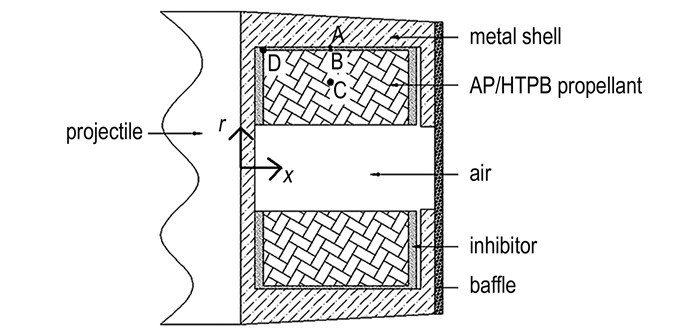
|
图 1 底排装置结构示意图 Fig.1 Schematic diagram of structure for the base bleeding unit |
根据此底排装置结构建立简化的二维烤燃模型, 并做出如下基本假设:
(1) AP/HTPB底排药的自热反应遵循Arrhenius定律。
(2) 装置左侧由于与弹体相连, 将装置左侧简化为绝热边界。
(3) 考虑到底排装置内空气腔较小, 忽略空气的对流效应。
(4) AP/HTPB底排药和壳体的物性参数均为常数, 不随温度变化。
3 数学模型及计算方法 3.1 基本方程本文基于AP/HTPB两步分解反应机理[14-15], 即AP的分解反应和HTPB与AP分解产物发生的放热反应:
| $ \underbrace{\text{N}{{\text{H}}_{\text{4}}}\text{Cl}{{\text{O}}_{4}}}_{\text{AP}\left( \text{X} \right)}\xrightarrow{{{R}_{1}}}\underbrace{{{\text{O}}_{\text{2}}}\text{+}{{\text{H}}_{\text{2}}}\text{O+HCl+}{{\text{N}}_{2}}}_{\text{decomposition product}\left( \text{Z} \right)} $ | (1) |
| $ \underbrace{\rm{HC}}_{\rm{binder}\left( \rm{Y} \right)}+\underbrace{\beta \left( {{\rm{O}}_{\rm{2}}}\rm{+}{{\rm{H}}_{\rm{2}}}\rm{O+HCl+}{{\rm{N}}_{2}} \right)}_{\beta Z}\xrightarrow{{{R}_{2}}}\underbrace{\rm{C}{{\rm{O}}_{\rm{2}}}\rm{+}{{\rm{H}}_{\rm{2}}}\rm{O+HCl+}{{\rm{N}}_{\rm{2}}}}_{\rm{Final products}} $ | (2) |
反应速率R1和R2如下形式[15]:
| $ {R_1} = {A_1}\exp \left( {-\frac{{{E_1}}}{{RT}}} \right){P^{{n_1}}}{p_{\rm{X}}} $ | (3) |
| $ {R_2} = {A_2}\exp \left( {-\frac{{{E_2}}}{{RT}}} \right){P^{{n_2}}}{p_{\rm{Y}}}{p_{\rm{Z}}} $ | (4) |
式中, β为AP/HTPB质量当量比, β=7.51; n1和n2为压力指数, n1=1.744, n2=1.75; A1和A2为指前因子; E1和E2为活化能; P=ρRT, ρX和ρY分别为物质AP(X)和HTPB(Y)的密度, ρZ为AP分解产物Z的平均密度; R为摩尔气体常数, 8.314 J·mol-1·K-1。
组分守恒方程
| $ \rho \frac{{{\rm{d}}{\omega _{\rm{X}}}}}{{{\rm{d}}t}} =-{R_1} $ | (5) |
| $ \rho \frac{{{\rm{d}}{\omega _{\rm{Y}}}}}{{{\rm{d}}t}} =-{R_2} $ | (6) |
| $ \rho \frac{{{\rm{d}}{\omega _{\rm{Z}}}}}{{{\rm{d}}t}} = {R_1}-\beta {R_2} $ | (7) |
式中,ωX、ωY、ωZ分别为物质X、Y、Z的质量分数, ρ为AP/HTPB底排药的密度, kg·m-3。
固相能量方程
| $ \rho {c_p}\frac{{\partial T}}{{\partial t}} = \frac{\lambda }{r}\left[{\frac{\partial }{{\partial r}}\left( {r\frac{{\partial T}}{{\partial r}}} \right) + \frac{\partial }{{\partial x}}\left( {r\frac{{\partial T}}{{\partial x}}} \right)} \right] + \sum {({R_i}{q_i})} $ | (8) |
式中,q1和q2分别为反应(1)和反应(2)的反应热, i=1, 2。
3.2 边界条件和初始条件金属壳体外壁面加热条件:
| $ {T_{\rm{S}}} = {T_0} + kt $ | (9) |
式中, T0为环境温度300 K。k为加热速率, Ts为壳体外壁温度, t为时间。
装置左侧边界壁面因连接弹体设为绝热边界
| $ {\lambda _i}\nabla {T_i} = 0 $ | (10) |
式中, λi代表金属壳体的导热系数, Ti代表金属壳体左侧壁面的温度
各相邻区域交界面有温度连续及热流连续条件:
| $ T_{r = {r_b}}^a = T_{r = {r_b}}^b $ | (11) |
| $ T_{x = {x_b}}^a = T_{x = {x_b}}^b $ | (12) |
| $ {\left. {{\lambda _a}\frac{{\partial {T^a}}}{{\partial r}}} \right|_{r = {r_b}}} = {\left. {{\lambda _b}\frac{{\partial {T^b}}}{{\partial r}}} \right|_{r = {r_b}}} $ | (13) |
式中, 下标a和b代表任意交界面处相邻的两种材料。
3.3 计算方法及网格划分采用计算流体力学fluent软件, 针对以AP/HTPB为特征组分的底排药, 建立二维底排装置模型, 对其在1~10 K·min-1加热速率下进行烤燃数值计算。因底排装置模型为二维轴对称结构, 所以计算时采用1/2模型进行计算。通过用户自定义标量(UDS)引入X、Y和Z三种组分, 利用用户自定义函数(UDF)的DEFINE_SOURCE宏引入公式(5)~(7)的组分方程源项和公式(8)的能量方程源项, 利用DEFINE_PROFILE宏引入外界加热边界条件, 计算时密度、能量和组分方程均采用二阶迎风格式。划分网格时在金属壳体区域采用三角形网格, 其他区域均采用以0.5 mm为单位的四边形网格, 共计40904个网格单元, 并经过网格无关性验证。
4 计算结果与分析 4.1 着火温度分析为验证计算模型的正确性, 根据文献[16]中对AP/HTPB复合固体推进剂进行的小型烤燃实验建立模型, 得出不同加热速率k下对应的实验着火温度Tf, 并且和实验数据进行比较, 结果如图 2所示。由图 2可知, 数值模拟计算结果与实验结果吻合较好, 着火温度的误差不超过3.4%, 证明上述AP/HTPB两步烤燃反应计算模型是合理的。
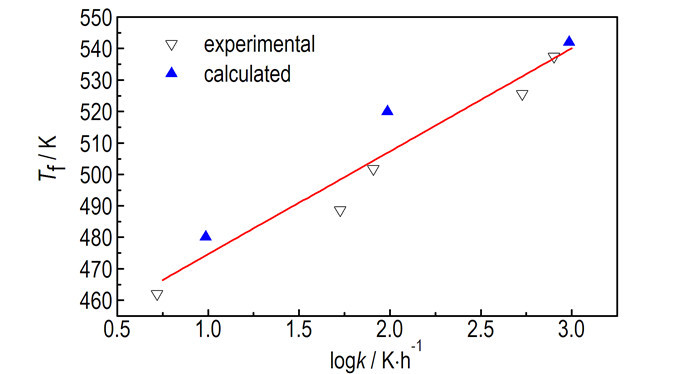
|
图 2 logk与Tf的关系 Fig.2 The relation of logk and Tf |
在计算模型合理的基础上, 对底排装置在1, 5, 10 K·min-1三种不同加热速率下进行数值模拟计算, 分析其在快速烤燃状态下的热响应过程, 计算AP/HTPB动力学参数及物性参数如表 1、表 2所示。
图 3a为1 K·min-1加热速率下底排装置在不同时刻的温度分布云图。从图 3a中可知, 在加热阶段前期, 由于金属壳体的导热系数远大于包覆层和AP/HTPB底排药的导热系数, 金属壳体的温度上升较快, 而热量向装置内底排药传递速度较慢, 金属壳体与装置内部的温度差随着时间的增加逐渐增大。当时间进行到14200 s时, 其最大温差达80 K。当AP/HTPB底排药的外端面温度逐渐升高时, AP/HTPB底排药进行缓慢的自热反应。当加热时刻进行到14336 s时, 此时在AP/HTPB底排药的左上角附近形成一个半圆形的高温区域, 此处的温度已高于金属壳体的温度, 说明底排药因自热反应所释放热量不能及时扩散, 导致反应过程迅速加速, 从而在底排药外端面形成高温响应区, 底排装置即将发生烤燃响应。烤燃响应区中心坐标约为(15.8, 57) mm。
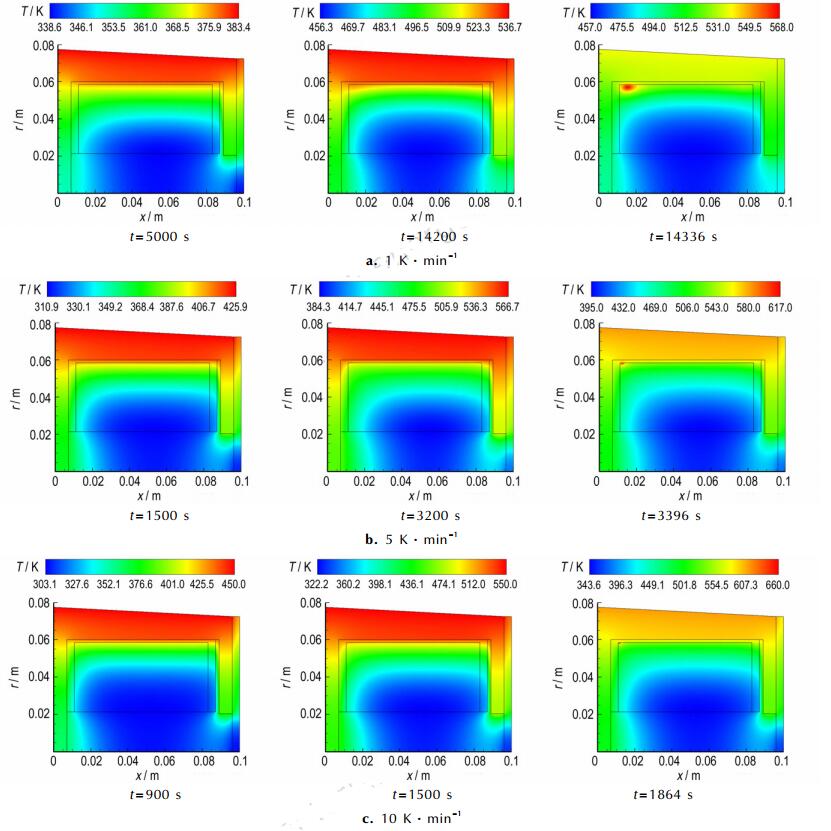
|
图 3 三种加热速率下不同时刻的底排装置温度分布云图 Fig.3 Temperature field cloud pictures of the base bleeding unit at different times under three heating rates |
图 3b和图 3c分别为5 K·min-1和10 K·min-1加热速率下底排装置在不同时刻的温度分布云图, 其烤燃响应过程与在加热速率为1 K·min-1的响应过程类似。上述两种加热速率分别在3396 s时和1864 s时, AP/HTPB底排药左上角外端面附近形成烤燃响应区, 响应区域中心点坐标分别约为(12.3, 58.3) mm和(11, 58.5) mm。
由上可知, 在1, 5 K·min-1和10 K·min-1三种加热速率下, 此底排装置最先发生烤燃响应区域均在AP/HTPB底排药的左侧端面处附近。随着外界加热速率的升高, 底排药最初着火位置略有变化, 但是对其影响较小。
图 4为不同加热条件下底排装置发生烤燃响应的着火时间与加热速率的关系图。在1, 5, 10 K·min-1三种加热速率下, 底排装置发生烤燃响应的时间分别为14336, 3396, 1864 s。从图 4中可知, 随着加热速率的提高, 底排装置发生烤燃响应的着火时间呈指数型衰减, 且着火时间缩短的速率也逐渐减小。
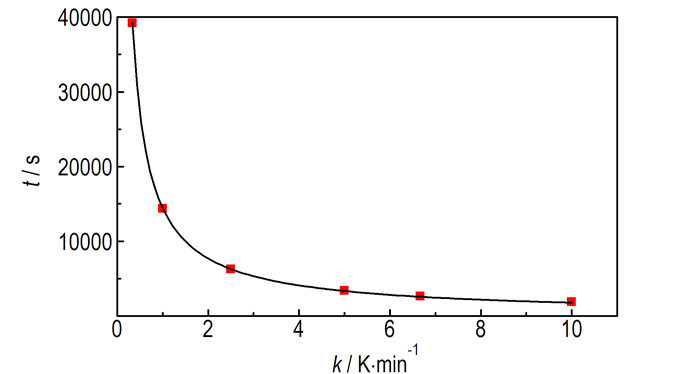
|
图 4 外界加热速率与底排装置着火时间的关系图 Fig.4 Relation of the external heating rate and ignition time of the base bleeding unit |
为研究底排装置在烤燃过程中内部的温度响应过程, 现选取A、B、C和D点四个观测点(如图 1所示), 其中D点为烤燃响应点, A、B和C点坐标依次为(47, 60.5) mm、(47, 58.5) mm和(47, 40) mm。从图 5中可知, 由于底排药的导热系数较小, 热量向底排药内部传递到的速度较慢, 所以在1~10 K·min-1的加热速率下底排药内部中心点C点的升温速率最小。底排药外表面B点和D点在烤燃响应发生之前温度相差较小, 当接近烤燃响应时刻即底排药内部开始发生自热反应后, 烤燃响应点D的温度上升速率会急剧增大, D点温度大于包覆层A点的温度, 表明烤燃响应区域热量开始瞬间释放, 底排装置发生烤燃热响应。在1, 5, 10 K·min-1三种加热速率下, 底排药AP/HTPB发生烤燃响应的着火温度依次为579.4, 574.0, 573.5 K, 由此可见在1~10 K·min-1的加热速率下, 外界加热速率的变化对底排药发生烤燃响应的着火温度影响较小。
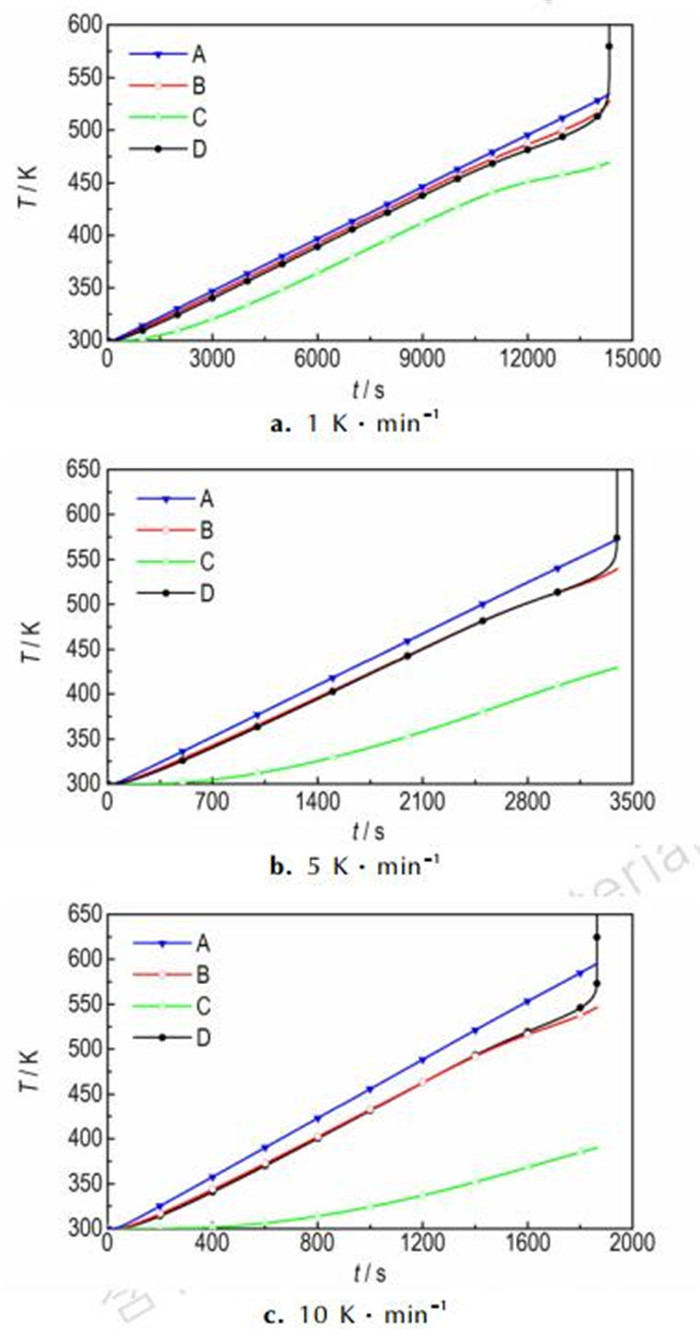
|
图 5 不同加热速率下各监测点的升温曲线 Fig.5 Temperature rise curves of the monitoring points at different heating rates |
(1) 针对以AP/HTPB为特征组分的底排药的热安全性问题, 基于AP/HTPB底排药两步化学反应机理, 建立了底排装置的二维非稳态烤燃模型。对文献[16]中的实验工况进行数值模拟计算, 计算结果与实验结果吻合较好, 验证了其烤燃反应模型的合理性。
(2) 在1, 5, 10 K·min-1三种加热速率下, AP/HTPB底排药最初的着火位置位于药剂外端面附近, 其着火区域中心点坐标依次为(15.8, 57) mm、(12.3, 58.3) mm和(11, 58.5) mm。随着加热速率的增大, 着火位置会向底排药外端面移动, 但影响略小。
(3) 在1, 5, 10 K·min-1加热速率下, 底排装置发生烤燃响应的时间分别为14336, 3396, 1864 s, 底排药AP/HTPB发生烤燃响应的着火温度依次为579.4, 574.0, 573.5 K。随着加热速率的提高, 底排装置发生烤燃响应的着火时间呈指数型衰减, 且着火时间缩短的速率也逐渐减小。外界加热速率的变化对底排药发生烤燃响应的着火温度影响较小。
| [1] |
Aydemir E, Ulas A. A numerical study on the thermal initiation of a confined explosive in 2-D geometry[J].
Journal of Hazardous Materials, 2011, 186(1): 396-400. DOI:10.1016/j.jhazmat.2010.11.015 |
| [2] |
Terrones G, Souto F J, Burkett M W, et al. The effect of cook-off on the bulk permeability of a plastic bonded explosive[J].
Propellants, Explosives, Pyrotechnics, 2006, 31(5): 333-342. DOI:10.1002/(ISSN)1521-4087 |
| [3] |
Yoh J J, Mcclelland M A, Maienschein J L, et al. Simulating thermal explosion of cyclotrimethylenetrinitramine-basedexplosives: Model comparison with experiment[J].
Journal of Applied Physics, 2005, 97(8): 1-11. |
| [4] |
张晓立, 洪滔, 王金相, 等. 不同热通量下炸药烤燃的数值模拟[J].
含能材料, 2011, 19(4): 436-441. ZHANG Xiao-li, HONG Tao, WANG Jin-xiang, et al. Numerical simulation of cook-off for explosive at different heat fluxs[J]. Chinese Journal of Energetic Materials(Hanneng Cailiao), 2011, 19(4): 436-441. |
| [5] |
张旭, 谷岩, 张远平, 等. TATB基PBX的快速烤燃实验与数值模拟[J].
含能材料, 2010, 18(5): 551-557. ZHANG Xu, GU Yan, ZHANG Yuan-ping, et al. Numerical simulation and experimental study of fast cook-off of TATB-based PBX explosive[J]. Chinese Journal of Energetic Materials(Hanneng Cailiao), 2010, 18(5): 551-557. |
| [6] |
Boldrev V. Thermal decomposition of ammonium perchlorate[J].
Thermochimica Acta, 2006, 443(1): 1-36. |
| [7] |
Beckstead M, Puduppakkam K, Thakre P, et al. Modeling of combustion and ignition of solid-propellant ingredients[J].
Progress in Energy and Combustion Science, 2007, 33(6): 497-551. DOI:10.1016/j.pecs.2007.02.003 |
| [8] |
Ho S Y, Ferschl T, Foureur J. Correlation of cook-off behavior of rocket propellants with thermo-mechanical and thermochemical properties[R]. Maribyrnong, Vic, Aus: Materials Research Laboratory, 1993.
|
| [9] |
Ho S Y. Thermomechanical properties of rocket propellants and correlation with cookoff behaviour[J].
Propellants, Explosives, Pyrotechnics, 1995, 20(4): 206-214. DOI:10.1002/(ISSN)1521-4087 |
| [10] |
Hedman T D, Gross M L, Davis J J, et al. Experimental investigation of the decomposition preceding cookoff in a composite propellant[J].
Journal of Propulsion and Power, 2014, 30(6): 1667-1674. DOI:10.2514/1.B35340 |
| [11] |
Caro R I, Bellerby J M. Behavior of hydroxyl-terminated polyether(HTPE) composite rocket propellants in slow cook-off[J].
International Journal of Energetic Materials and Chemical Propulsion, 2008, 7(3): 171-185. DOI:10.1615/IntJEnergeticMaterialsChemProp.v7.i3 |
| [12] |
陈中娥, 唐承志, 赵孝彬. 固体推进剂的慢速烤燃行为与热分解特性的关系研究[J].
含能材料, 2005, 13(6): 393-396. CHEN Zhong-e, TANG Cheng-zhi, ZHAO Xiao-bin. Relationship between slow cook-off behavior and thermal decomposition characteristics of solid propellant[J]. Chinese Journal of Energetic Materials(Hanneng Cailiao), 2005, 13(6): 393-396. |
| [13] |
陈广南, 张为华.
固体火箭发动机撞击与热安全性分析[M]. 北京: 国防工业出版社, 2008: 9-11.
CHEN Guang-nan, ZHANG Wei-hua. Safety analyses for solid rocket motors under insults of impact and heat[M]. Beijing: National Defense Industry Press, 2008: 9-11. |
| [14] |
Hegab A, Jackson T L, Buckmaster J, et al. Nonsteadyburning of periodic sandwich propellants with complete coupling between the solid and gas phases[J].
Combustion and Flame, 2001, 125(1): 1055-1070. |
| [15] |
Gwak M, Jung T, Yoh J J. Friction-induced ignition modeling of energetic materials[J].
Journal of Mechanical Science and Technology, 2009, 23(7): 1779-1787. DOI:10.1007/s12206-009-0603-1 |
| [16] |
Komia I, Sato W. Reaction mechanism in slow cook-off tests of GAP-AP propellants[C]//In: Insensitive Munitions and Energetic Materials Symposium (IMEMTS), Bristol, UK, 2006.24-28.
|
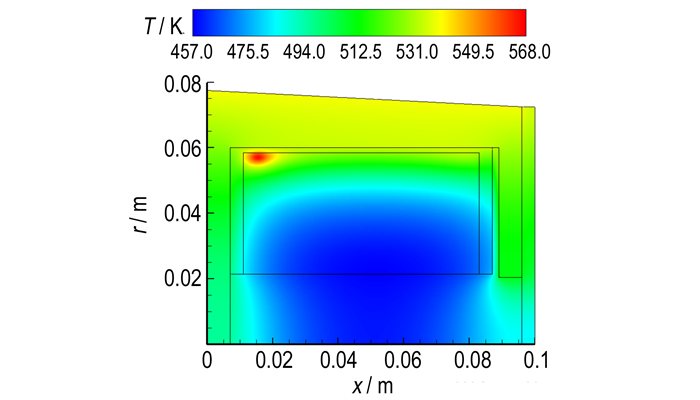
The cook-off characteristics of ammonium perchlorate(AP)/hydroxyl-terminatedpolybutadiene(HTPB) base bleeding propellant in base bleeding unit were studied at the heating rates of 1, 5 K·min-1 and 10 K·min-1, respectively.




